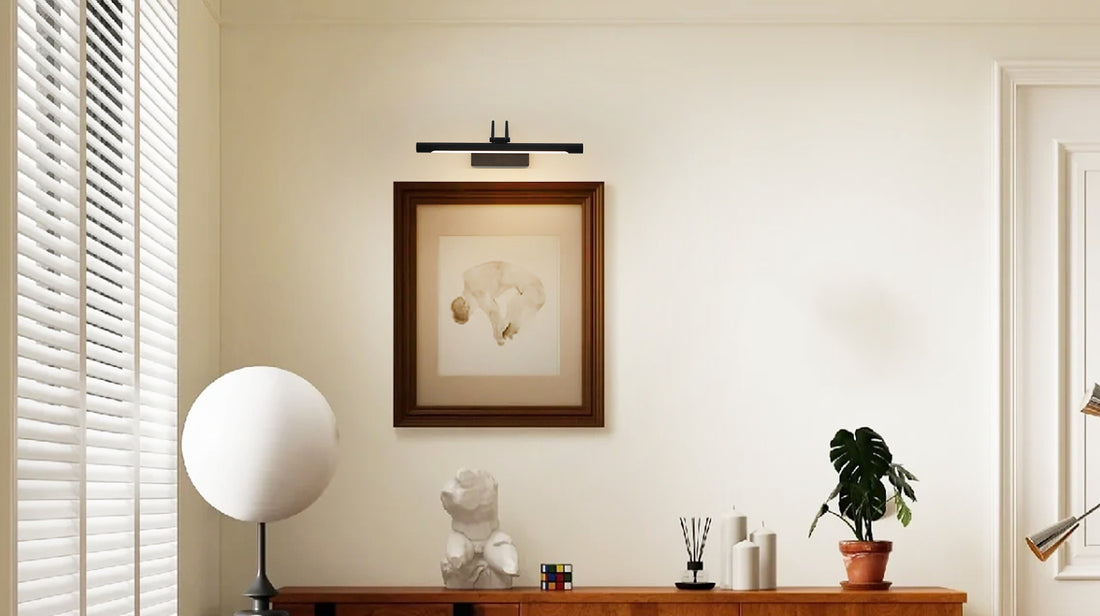Inappropriate lighting can diminish even the most magnificent piece of art to a mediocre one. After all, if glares and shadows impede beauty, what good is it? Any home can be made more lively by beautiful artwork, and this impression should be enhanced by adequate lighting. Lighting can either draw attention to or take away from an artwork's most notable feature. If the piece of art you bought and hung up is harshly exposed to sunshine or is covered in shadows, it may not have the same powerful impact that initially drew you in.
In addition to these aesthetic considerations, using the right lighting techniques can guarantee the longest possible lifespan for your artwork, allowing it to be safely viewed for many years to come.
Here are some helpful hints from The Artling Artzine to help you light your artwork:
1.Stay away from direct sunlight.
When artworks are exposed to UV and infrared light in direct sunlight, pigment in paints and prints will fade. Make sure your artwork is away from intense natural light to prevent damage. Direct natural light may even harm your furniture and carpeting, while indirect natural light does not have the same impact.
Experts recommend that light come from the north; artist studios especially promote this. A less complicated solution would be to place your artwork against a wall where light doesn't shine directly on it.

2.Recognize the room's balance.
It is not necessary for your artwork to be the brightest item in the space; it should just be bright enough to show off its colors and textures. Without being overt or obtrusive, excellent lighting should highlight a piece's inherent beauty. Remember that not every piece needs to be illuminated; darker pieces will require more light than brighter ones. You should be able to leave it exactly how it is unless it improves the piece's aesthetic appeal or the atmosphere of the space.

3.Making use of artificial light? Make sure you select the appropriate one.
Instead of focusing on the lighting itself, good Art lighting should highlight what it is. A useful tip to make sure your artwork's colors are displayed accurately is to make sure the lights you choose have a High Color Rendering Index (CRI) percentages. The colors will appear brighter the closer they are to 100%.
There are numerous approaches to properly lighting an artwork. The one constant throughout all of them is to never use fluorescent lights because they are an artificial light source that is excessively bright and white. Using daylight-replicating lights might be a safer solution.
The warm, cozy glow produced by incandescent lamps is replicated. However, when choosing this type of art lighting, keep in mind that they might be rather inefficient.
LED art light fixture could be a good option if there isn't much room between the light source and the artwork because of its extended lifespan and low UV and heat emissions. Additionally, they are made in a range of warm and chilly temperatures.

4.Which light for art options do you have?
Picture light or Track lights
Track lights are bulky track-lighting that seemed to interfere with space as if they were art installations of their own.
Picture lights are fixtures that are put directly on the frames of artwork or fixed on the wall. It provides a light source close to the artwork by utilizing low wattage bulbs. This establishes a feeling of closeness with the artwork and generates a display that invites visitors to get closer.
The primary distinction between led light wall art and spotlights is that the former produces a pool of light over an artwork, while the latter has a more distinct cut-off. Other than that, it is up to the client: picture lights are available in a variety of sizes, styles, colors, and finishes to complement both traditional and modern architecture.

5.Select the appropriate LEDs
According to Triggs, a subpar LED can provide a drab, sickly light that looks "like a doctor's waiting room." He suggests a color temperature of 2,700K or 2,800K, a color rendering index (CRI) of 90 or above, and a reliable manufacturer to guarantee the constancy of both attributes from one LED to the next for the ideal lighting in a household setting.
Richer colors are where most LEDs falter, according to Triggs. "Regal reds and royal blues look flat when lit by a low-quality LED; a high-quality LED will really bring out the details and definition in them." Once more, Molyneux shows off by putting two lights up to a picture of a woman. The woman's gold hair and red clothing are far more vivid in his company's light, which replicates 100% of the color spectrum, than they are in the other light, which only reproduces 80%.hich reproduces only 80 per cent.
6.Make sure the lighting is equal.
Keeping the lighting of all artworks same is crucial. Irrespective of the media, this principle ought to be followed in order to showcase not just the piece of art but also its subtleties and facts. As previously said, there are various approaches to ensure accuracy, ranging from installing multiple low beam lights from different angles to having a single lighted wall art.
Sustaining even lighting also means using museum-quality glass to prevent distracting reflections that could impair the viewing of an artwork and angling light sources away to prevent harsh shadows cast on artworks.

7.Become intimate and personal
Check to see if the lighting is properly illuminating your artwork,both up close and from a distance after selecting and installing the appropriate setting. When viewed from a distance, an artwork that is well-lit up close can not always have the same impact. Its size, texture, and maybe the frame it's in can all be blamed for this.
Throughout this entire process, preference also counts, so consider how you want your artwork to be illuminated in relation to the rest of the room in which it is displayed!

